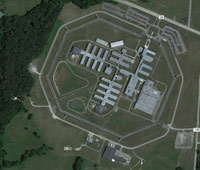On April 3, 2014, the ACLU of Ohio toured the Southern Ohio Correctional Facility (SOCF), a high security prison located in southern Ohio better known by the moniker “Lucasville.”
Below are some reflections on our visit to SOCF, from three of the staff members who visited the facility.
Adrienne Gavula, Associate Director:
What immediately struck me during our tour of SOCF was the level of control. We rarely walked more than 12 or so steps without a set of bars that needed to be opened.
Inmates walk in small, controlled groups to lunch, to recreation, and to their cells. The air in the cellblock is stifling. This feeling was especially prominent in the smaller, more confined mental health unit.
When taken from their cells to group activity, the hands of the highest security “4B” inmates are chained to the table. For recreation, these prisoners are placed in cages with exercise equipment. Often they forego exercise, instead taking advantage of one of the only opportunities they have to engage in conversation with other inmates.
The tour reminded me that prison is a truly oppressive place, especially at the more restrictive levels. I came away with a renewed commitment to ensure that our criminal justice system uses prison — the ultimate deprivation of liberty — as a last resort.
Jocelyn Rosnick, Policy Researcher:
The first area of Lucasville that I visited was the Residential Treatment Unit (RTU), a cell block that houses many inmates suffering from serious mental illness.
I immediately noticed the high level of security, the dim lighting, the stale air and the eerie quiet. Most RTU inmates simply paced in their cells or sat on their beds. The cells were small, with little outside light filtering in, and bars or a screen window separating them from the unit staff.
This kind of isolation can be psychologically harmful to any inmate, but it can be even worse for inmates suffering from serious mental illness. Often when inmates are housed in these kinds of isolation units, they become much less likely to rehabilitate.
This visit reaffirmed my belief that we need to reexamine how we treat individuals with mental illness in our criminal justice system. If we are truly committed to focusing on rehabilitation over punishment, we must take a stand against the over-reliance on this kind of solitary confinement, especially for those with mental illness.
Nick Worner, Communications Coordinator:
I toured SOCF while doing research for an article dealing with the 21st anniversary of the Lucasville prison uprising. What struck me immediately was how the ghosts of this event still loom heavy over SOCF.
Though prison officials rarely discussed the uprising directly, it was clear that many of the security protocols that are in place today are there because of what happened in 1993.
I was unprepared for just how small a Lucasville prison cells really is. Seeing a man caged inside a space roughly the size of a gas station bathroom was jarring, but I can only imagine how it looked in 1993, when many of these cells housed two men and the entire facility was hopelessly overcrowded.
In many ways, SOCF is a very different facility today from the one it was two decades ago. What will never change is the fact that a prison cell is not a comfortable or a desirable place to be.

